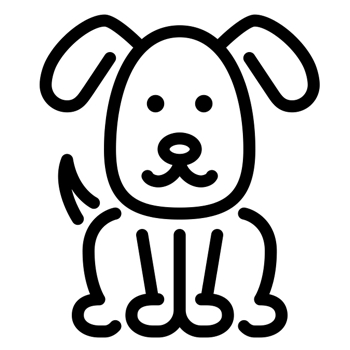German Shorthaired Lab

The German Shorthaired Lab, sometimes referred to by its more complete name, the German Shorthaired Labrador Retriever, is a medium-sized dog with an athletic build and tons of energy and enthusiasm and, as you may have already guessed from the name, is a cross between the German Shorthaired Pointer and the Labrador Retriever. Always on the move, these dogs thrive in rural settings and require plenty of exercise and space to keep them fit and happy.
A handsome dog with a noble appearance, the German Shorthaired Lab tends to look like a wiry and more muscular Labrador that can be bred in a larger variety of coat colours and patterns. Their short, dense fur is low maintenance however will shed a lot, particularly when the weather is warm.
About & History
Records on the initial breeding of the German Shorthaired Lab are sadly lacking and experts can only estimate when and where they first originated. However, we can learn plenty about their history by taking a closer look at each parent breed – the German Shorthaired Pointer and the Labrador Retriever.
The German Shorthaired Pointer
The German Shorthaired Pointer is well-liked for its ability to work efficiently on both land and water and is still used by hunters today, particularly in Germany and the surrounding countries. Their biddable personalities and gentle natures have ensured that they are also seen as good family pets and many individuals will be kept for company rather than as working dogs.
A relatively new breed, it wasn’t until the mid 1800s that the German Shorthaired Pointer became officially established. They were bred from a good mixture of dogs, including the English Pointer, the Weimaraner and the Hungarian Vizsla.
The Labrador Retriever
A very popular pet dog indeed, the Labrador Retriever frequently tops the most popular breed list in countries all over the world. This title has been hard-earned through the years, with Labradors proving themselves time and time again as dependable and loving pets who can be trusted with children and are incredibly easy-going. Most assume that this breed was established in Labrador but they actually come from Newfoundland, a neighbouring Canadian province. Indeed, the Newfoundland dog breed was used in the creation of the Labrador, alongside smaller water dogs.
Imported to England in large numbers during the 1800s, the Labrador quickly established itself and, as well as the original black dogs, yellow and chocolate examples of the breed quickly became accepted. Traditionally used as gun dogs, modern Labradors are now utilised in a wide variety of areas, frequently seen as service dogs, search and rescue dogs and even therapy dogs.
Appearance
German Shorthaired Labs have a pleasing appearance with good muscling and a truly athletic conformation. Their skull is large and broad with a strong muzzle that doesn’t tend to be as long as that of the Pointer. Their ears are typically big and wide, often reaching past their jaw. They are robust yet elegant, carrying themselves with a quiet dignity. Their limbs are long and strongly built yet still allow for a quick turn of pace. They usually have a wide tail, which is particularly thick at the base.
While there is a degree of variation, most German Shorthaired Labs will weigh between 25kg and 30kg and will measure from 53cm to 60cm. The short coat of the German Shorthaired Lab may well be the classic Labrador coat colours of black, chocolate and yellow but will frequently have white ticking and markings.
Character & Temperament
Adventurous and jubilant, German Shorthaired Labs are a real pleasure to be around and it is difficult to stay in a bad mood for too long when in their company! They approach all tasks set to them with glee and gusto and never shy away from a new challenge. They have seemingly endless energy and require plenty of stimulation, both mental and physical, to keep them content.
When it comes to being sociable, the German Shorthaired Lab is an undeniable social butterfly. Friendly and outgoing, these dogs love to be in human company, particularly relishing the opportunity to play with young children and goof around. Despite this, parents should be sure to monitor youngsters in their company, to avoid them being knocked over by an over-excited pooch. These dogs really do live to please their owners and will always try to be cooperative and well-mannered.
Rarely hostile, the German Shorthaired Lab makes a poor guard dog, though a select number of breed members may at first be wary and quiet around new people. Thorough socialisation when young can ensure that they quickly grow out of any shyness.
Trainability
A breed of above average intelligence that is eager to show off their ability and cooperate, these dogs make excellent training partners. At times, their enthusiasm may get the best of them and they can have a short attention span, getting easily distracted; particularly if training outdoors around interesting sights and smells. Whether they spot a rabbit running in the distance or a canine friend that has been let off the lead nearby, it can sometimes be hard for them to concentrate on their training. Owners can keep their focus by ensuring sessions are kept short and interesting and by offering tasty treats as a means of incentive.
Behavioural issues, such as constant barking or digging, can occur when a German Shorthaired Lab becomes bored or under-stimulated. Owners must attempt to avoid this whenever possible by ensuring they are given plenty to do.
Health
With an average lifespan of around 10 to 12 years, the majority of German Shorthaired Labs will live healthy lives. However, there are a number of conditions that we know can pose a problem in this hybrid dog breed.
Hip & Elbow Dysplasia
Malformed joints can occur in both the fore and hind limbs with the hips and elbows being most commonly affected. As signs in a young dog can be subtle and may wax and wane, owners and vets must be sure to keep a close eye on any lameness or gait abnormalities the moment they present.
Though X-rays are generally sensitive enough to detect hip dysplasia, more advanced imaging (such as a CT scan) is often advised to detect elbow dysplasia. For some dogs, surgical intervention is advised, while others are managed with a combination of lifestyle changes and medication.
Bloat
Though it is well-recognised that bloat can occur in any dog, it has been proven that it is more often seen in larger breeds with deep chests. This is a dangerous condition that comes on with little warning and can kill a dog within a number of hours.
Those affected will initially struggle to settle down and will pace up and down, pant and retch. Their abdomen will become distended and this is the reason for the name ‘bloat’. Prompt intervention can save a dog’s life and the sooner the bloat is treated by a veterinarian, the better the animal’s prognosis.
Obesity
Recent studies have proven the genetic link to obesity present in the Labrador Retriever and it is clear to see that some breeds are more likely to become over-weight than others (for example, an obese Greyhound is not a common sight!).
However, this does not mean that every Lab cross will inevitably become fat as they reach middle-age and correct diet and exercise should be enough to prevent obesity, even in those that are genetically predisposed. As obesity reduces a dog’s quality of life and is linked to a number of diseases, such as Osteoarthritis and Heart Disease, it is to be avoided at all costs.
Exercise and Activity Levels
Lively dogs that need a couple of hours of exercise every day, the German Shorthaired Lab is a good breed of dog for families who spend lots of time outside and have access to plenty of land. Ideally, they would be able to spend some time running off lead every day and should also be given the opportunity to swim and explore new routes when possible.
Grooming
During the summer, owners may find that they need to groom their German Shorthaired Lab twice every day to reduce the amount of fur being shed within the home. This degree of brushing won’t be required in the winter but they do lose a substantial amount of fur all year round. Their short coat does not get matted and is quick and easy to brush through. The pendulous ears of this breed are prone to infections if not regularly cleaned.

